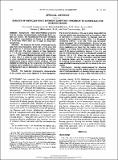| dc.contributor.author | Soumerai, Stephen Bertram | |
| dc.contributor.author | Ross-Degnan, Dennis | |
| dc.contributor.author | Avorn, Jerry Lewis | |
| dc.contributor.author | McLaughlin, Thomas J. | |
| dc.contributor.author | Choodnovskiy, Igor | |
| dc.date.accessioned | 2017-05-16T18:41:18Z | |
| dc.date.issued | 1991 | |
| dc.identifier.citation | Soumerai, Stephen B., Dennis Ross-Degnan, Jerry Avorn, Thomas J. McLaughlin, and Igor Choodnovskiy. 1991. “Effects of Medicaid Drug-Payment Limits on Admission to Hospitals and Nursing Homes.” New England Journal of Medicine 325 (15) (October 10): 1072–1077. doi:10.1056/nejm199110103251505. | en_US |
| dc.identifier.issn | 0028-4793 | en_US |
| dc.identifier.uri | http://nrs.harvard.edu/urn-3:HUL.InstRepos:32696157 | |
| dc.description.abstract | BACKGROUND.
Many state Medicaid programs limit the number of reimbursable medications that a patient can receive. We hypothesized that such limitations may lead to exacerbations of illness or to admissions to institutions where there are no caps on drug reimbursements.
METHODS.
We analyzed 36 months of Medicaid claims data from New Hampshire, which had a three-drug limit per patient for 11 of those months, and from New Jersey, which did not. The study patients in New Hampshire (n = 411) and a matched comparison cohort in New Jersey (n = 1375) were Medicaid recipients 60 years of age or older who in a base-line year had been taking three or more medications per month, including at least one maintenance drug for certain chronic diseases. Survival (defined as remaining in the community) and time-series analyses were conducted to determine the effect of the reimbursement cap on admissions to hospitals and nursing homes.
RESULTS.
The base-line demographic characteristics of the cohorts were nearly identical. In New Hampshire, the 35 percent decline in the use of study drugs after the cap was applied was associated with an increase in rates of admission to nursing homes; no changes were observed in the comparison cohort (RR = 1.8; 95 percent confidence interval, 1.2 to 2.6). There was no significantly increased risk of hospitalization. Among the patients in New Hampshire who regularly took three or more study medications at base line, the relative risk of admission to a nursing home during the period of the cap was 2.2 (95 percent confidence interval, 1.2 to 4.1), and the risk of hospitalization was 1.2 (95 percent confidence interval, 0.8 to 1.6). When the cap was discontinued after 11 months, the use of medications returned nearly to base-line levels, and the excess risk of admission to a nursing home ceased. In general, the patients who were admitted to nursing homes did not return to the community.
CONCLUSIONS.
Limiting reimbursement for effective drugs puts frail, low-income, elderly patients at increased risk of institutionalization in nursing homes and may increase Medicaid costs. | en_US |
| dc.language.iso | en_US | en_US |
| dc.publisher | New England Journal of Medicine (NEJM/MMS) | en_US |
| dc.relation.isversionof | doi:10.1056/NEJM199110103251505 | en_US |
| dash.license | LAA | |
| dc.title | Effects of Medicaid Drug-Payment Limits on Admission to Hospitals and Nursing Homes | en_US |
| dc.type | Journal Article | en_US |
| dc.description.version | Version of Record | en_US |
| dc.relation.journal | New England Journal of Medicine | en_US |
| dash.depositing.author | Soumerai, Stephen Bertram | |
| dc.date.available | 2017-05-16T18:41:18Z | |
| dc.identifier.doi | 10.1056/NEJM199110103251505 | * |
| dash.contributor.affiliated | McLaughlin, Thomas | |
| dash.contributor.affiliated | Avorn, Jerome | |
| dash.contributor.affiliated | Ross-Degnan, Dennis | |
| dash.contributor.affiliated | Soumerai, Stephen | |


